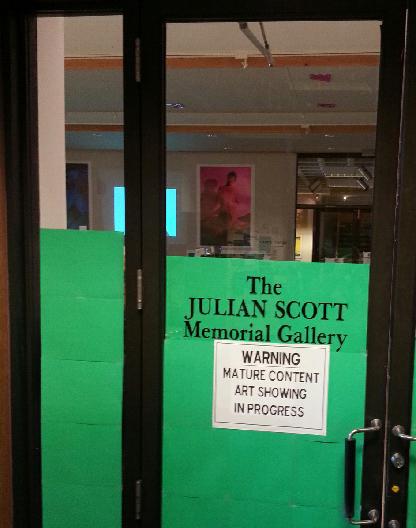Ceci n’est pas Sex!
*Author’s Note: This op-ed was written before the latest shootings at a “Draw the Prophet Mohammed” contest in Garland, Texas. While I would in no way defend the militants for attempting to shoot up the contest, the very concept of that contest is also despicable. But just as the ACLU defended the rights of the National Socialist Party of America to parade with their swastika flags in Skokie back in 1977, we’re compelled to defend the free speech rights of those lunkheads at the American Freedom Defense Initiative when they brazenly incite fire with their shameless contest. I could write another op-ed on the power of images, but the bottom line is that insofar as images ARE indeed powerful, it’s even more important that we defend the right to make them and share them.
On Friday, April 24th I found the doors of the Julian Scott Gallery locked during their regularly posted hours. The lights were out and the view into the gallery was blocked by paper hastily scotch-taped over doors and windows. I’m not going to guess the motives of the perpetrator(s), but it is clear that they failed to understand the role of art and the meaning of metaphor.
Our Graphic Novels class just read a case in point in Scott McCloud’s Understanding Comics. The Treachery of Images is a famous 1929 painting by Rene Magritte—the great 20th Century Belgian artist. The painting consists of a carefully rendered tobacco pipe, with a phrase elegantly scripted below—“Ceci n’est pas un pipe”. (“This is not a pipe.”) What at first seems ridiculous, given further thought brings the viewer to the intended meaning. Of course it is not a pipe—it’s just a picture of a pipe—an image, not the real thing. Can’t hold it, fill it with tobacco or smoke it. That’s a point that is almost so obvious that it’s a wonder it had to be said…..until…..
….until you note how frequently people confuse an image with the real thing—
Andre Serrano’s Immersion (Piss Christ), created in 1987, depicts an ordinary plastic crucifix in a glowing yellow stream. It’s worth Googling that image to see it—vibrant and mysterious compared with Magrittes’ straightforward pipe. At the time some were outraged at what they saw to be a blasphemous pissing on religion—not just an image, but the actual act of pissing on Jesus, as if Magritte’s painting really was a pipe. Yet it was equally likely that Serrano was depicting what contemporary culture has done to the teachings of Christ—and a plastic, mass-produced Christ at that. Maybe Serrano wasn’t pissing on Jesus at all—maybe he was showing us what all of us have been doing—telling us that WE have been pissing on Christ. Should we shut Serrano’s image down, or look at it, think about it and decide to stay or leave? Any one of us may well decide we don’t like it—but should any of us be able to lock the rest of us out from seeing it? Ceci n’est pas Christ! More recently we could have used Magritte to paint us a Ceci n’est pas Mohammed, to hang next to the offices of Charlie Hebdo. A cartoon of Mohammed is NOT Mohammed, dammit!*
In their Julian Scott exhibitions, Jessie Warren, Blaze Nicolosi and Lance Carron all presented work showing human figures floating through their imaginations in fascinating ways. But I’m not going to pretend not to know which work precipitated the lock-down. Lance Caron’s digitally created photographs depict two of the same model, skillfully Photoshopped to suggest a man kissing himself, or another sweetly snoozing, cuddled up to himself. Another of a female is in a more passionate moment—albeit PG-13 at best–with herself. Or a man mounting himself from the rear—it not being clear if this is a welcomed advance or excruciating. So what is this? Remember, Ceci n’est pas un pipe!It isn’t a kiss or a cuddle or sex or sodomy—It’s just a picture of a kiss or a cuddle or……..WAIT A MINUTE! It might not even be that! It might be an image of self-love. Or a fantasy of the perfect love–feeling so at-one with a lover that we could become that lover. Or a metaphor for us deluding ourselves or screwing ourselves or, sure, masturbation—maybe that. Or maybe not—maybe about self-acceptance. And it must be remembered that this was not documentary photography—these were highly manipulated multiple images that never actually occurred or could ever have occurred as seen. Or, well, there you have it—it’s all of the above and none of the above, which is why it’s so interesting. Which is why it’s art. Which is why it’s great that all of us can decide for ourselves if we should stay or leave.
An art gallery is a forum for ideas, in the same way that this newspaper is. To be honest, this exhibition didn’t come near the intensity of images out there that we might have been challenged with–nothing in any of these images is stronger than what any of us could find on television any night of the week. Ironically, had they shown two different models instead of the same one duplicated, then the images would have referred less to imagined states and more to actual possibilities. Would that have been more or less disturbing? There’s only one way to find that out—which is why I’m glad Lance and Jesse and Blaze and all artists are out there to wander through ideas and give us the chance to think in wonder or disgust or amazement or….
Of course I was furious that whoever locked the Gallery last Friday hadn’t had the courtesy to first contact the artists involved or the art department sponsoring the exhibits—senior capstone thesis exhibits of three outstanding art students. Apparently the perpetrator(s) didn’t even think it possible that they might have misunderstood the artwork, or that a discussion was warranted.
When I saw those locked doors, I decided the “price” of that act was a campus-wide discussion. And that is exactly what has happened, and we’re all the better for it.





